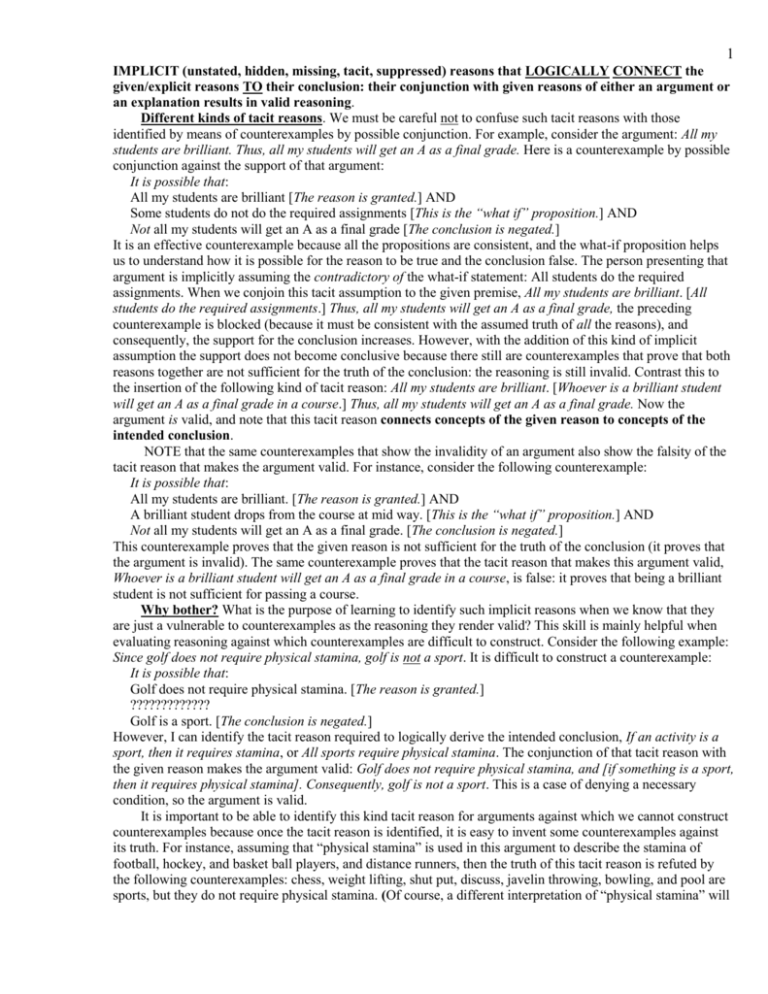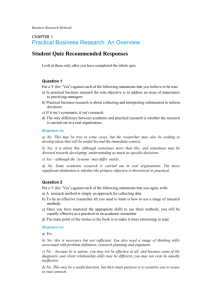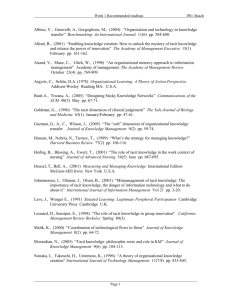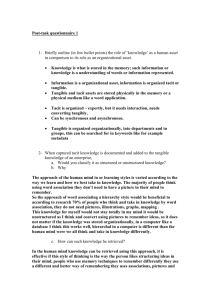IMPLICIT (unstated, hidden, missing, tacit, suppressed) premises
advertisement

1 IMPLICIT (unstated, hidden, missing, tacit, suppressed) reasons that LOGICALLY CONNECT the given/explicit reasons TO their conclusion: their conjunction with given reasons of either an argument or an explanation results in valid reasoning. Different kinds of tacit reasons. We must be careful not to confuse such tacit reasons with those identified by means of counterexamples by possible conjunction. For example, consider the argument: All my students are brilliant. Thus, all my students will get an A as a final grade. Here is a counterexample by possible conjunction against the support of that argument: It is possible that: All my students are brilliant [The reason is granted.] AND Some students do not do the required assignments [This is the “what if” proposition.] AND Not all my students will get an A as a final grade [The conclusion is negated.] It is an effective counterexample because all the propositions are consistent, and the what-if proposition helps us to understand how it is possible for the reason to be true and the conclusion false. The person presenting that argument is implicitly assuming the contradictory of the what-if statement: All students do the required assignments. When we conjoin this tacit assumption to the given premise, All my students are brilliant. [All students do the required assignments.] Thus, all my students will get an A as a final grade, the preceding counterexample is blocked (because it must be consistent with the assumed truth of all the reasons), and consequently, the support for the conclusion increases. However, with the addition of this kind of implicit assumption the support does not become conclusive because there still are counterexamples that prove that both reasons together are not sufficient for the truth of the conclusion: the reasoning is still invalid. Contrast this to the insertion of the following kind of tacit reason: All my students are brilliant. [Whoever is a brilliant student will get an A as a final grade in a course.] Thus, all my students will get an A as a final grade. Now the argument is valid, and note that this tacit reason connects concepts of the given reason to concepts of the intended conclusion. NOTE that the same counterexamples that show the invalidity of an argument also show the falsity of the tacit reason that makes the argument valid. For instance, consider the following counterexample: It is possible that: All my students are brilliant. [The reason is granted.] AND A brilliant student drops from the course at mid way. [This is the “what if” proposition.] AND Not all my students will get an A as a final grade. [The conclusion is negated.] This counterexample proves that the given reason is not sufficient for the truth of the conclusion (it proves that the argument is invalid). The same counterexample proves that the tacit reason that makes this argument valid, Whoever is a brilliant student will get an A as a final grade in a course, is false: it proves that being a brilliant student is not sufficient for passing a course. Why bother? What is the purpose of learning to identify such implicit reasons when we know that they are just a vulnerable to counterexamples as the reasoning they render valid? This skill is mainly helpful when evaluating reasoning against which counterexamples are difficult to construct. Consider the following example: Since golf does not require physical stamina, golf is not a sport. It is difficult to construct a counterexample: It is possible that: Golf does not require physical stamina. [The reason is granted.] ????????????? Golf is a sport. [The conclusion is negated.] However, I can identify the tacit reason required to logically derive the intended conclusion, If an activity is a sport, then it requires stamina, or All sports require physical stamina. The conjunction of that tacit reason with the given reason makes the argument valid: Golf does not require physical stamina, and [if something is a sport, then it requires physical stamina]. Consequently, golf is not a sport. This is a case of denying a necessary condition, so the argument is valid. It is important to be able to identify this kind tacit reason for arguments against which we cannot construct counterexamples because once the tacit reason is identified, it is easy to invent some counterexamples against its truth. For instance, assuming that “physical stamina” is used in this argument to describe the stamina of football, hockey, and basket ball players, and distance runners, then the truth of this tacit reason is refuted by the following counterexamples: chess, weight lifting, shut put, discuss, javelin throwing, bowling, and pool are sports, but they do not require physical stamina. (Of course, a different interpretation of “physical stamina” will 2 affect the kinds of counterexamples we can advance against the truth of this tacit reason. A complete evaluation of this argument would require us to consider various reasonable interpretations of “physical stamina”, and choose the interpretation that results in the strongest support AND the most likely tacit reason. However, I am using this example just to illustrate the kind of reasoning for which it is important to identify the kind of implicit reason that makes the reasoning valid.) Therefore, though our reconstruction of the reasoning results in a valid argument, it rests on a false tacit reason, and so the argument fails to establish the truth of the conclusion from the given reason. (NOTE: I am not saying that the conclusion is false, for some other argument could establish its truth.) Here are some guidelines for inserting the best tacit reasons to make an argument or explanation valid: Principle of FIDELITY (loyalty to an author’s intentions AND frame of mind) (1) When our goal is to represent as accurately as possible an author’s own argument (or explanation), we must reconstruct the argument (or explanation) according the author’s intentions, goals, knowledge, and beliefs, and according to his/her use of key words in the argument (or explanation). We must insert only the reasons that the author would accept, or would be logically obliged to accept in order to support (in the case of arguments) the conclusion to the degree that s/he intends to provide. Here are some clues to take into consideration: (i) the author’s use of qualifying expressions, e.g. probably, necessarily; (ii) the context; (iii) one's knowledge of the author's beliefs. (2) Whenever inserting implicit reasons, we must not render the given/explicit premises superfluous. For example, imagine that we are given the argument, Dracula is a vampire, so Dracula is not a strict vegetarian, and let’s suppose that we happen to know that the author also believed that Dracula eats meat, and that we reconstruct the argument as follows: (1) Dracula is a vampire. [2] [Dracula eats meat.] [3] [Whoever eats meat is not a strict vegetarian.] (4) So, Dracula is not a strict vegetarian. The added tacit reasons [2] and [3] are sufficient by themselves for the truth of the conclusion; for it’s impossible for [2] and [3] to be true and (4) false. Consequently, the conclusion no longer needs the given premise that (1) Dracula is a vampire. Consequently, if we use [2] and [3] as tacit reasons, they render the given (explicit) premise unnecessary, or superfluous. However, since the author is actually using (1) in support of the conclusion, this reconstruction of his/her argument does not conform to his/her intentions: we are violating the interpretive principle of fidelity. Note also that [2] and [3] do not logically connect (1) to (4). Stated more generally: Given any argument "P, so Q", where “P” stands for any number of reason, and the reconstruction of the argument as "P & [S], so Q", the implicit premise S renders the given premise(s) P superfluous if S by itself supports Q to the degree intended by the author. Such a reconstruction violates the principle of fidelity. Why bother? Why should we bother with the interpretive principle of fidelity? Striving to reconstruct an argument according to its author’s intentions helps us to diminish our chances of presenting a straw man argument, which is criticism against a misrepresentation of the author’s argument; in such cases our objections are completely off target, even if they do in fact refute the misrepresentation. What should we do when (i) we don't know the intended degree of support, or (ii) we must make a choice among competing tacit premises, or (iii) our goal is to find out whether we should accept the intended conclusion given the author's premises? In such situations we use the Principle of GENEROSITY (principle of charity). We insert a true or the most probable reason(s) that will connect the given reason(s) to the conclusion and provide the strongest support for the conclusion. Why bother? (i) People generally try to present the strongest arguments. (ii) It is only after we have made the best reconstruction that we will be in a position to reject an argument. For if we do not respond to the strongest version of an argument, someone could advance a stronger version of the same argument, thereby showing that our criticism is off target, misguided, and irrelevant. If the best reconstruction of an argument capitulates against our objections, then we have sufficient reason not to accept the conclusion from the given reason. (Don’t forget, the conclusion might be established from different reasons.) If the best reconstruction withstands our best objections, then we have sufficient reason to accept or at least be open to the conclusion. 3 General rules to conform to the two interpretive principles: tacit reasons should 1) be consistent among themselves and with the given reasons; 2) not make the given premises superfluous; 3) be true, as likely as possible, acceptable, verifiable; 4) be informative: the tacit premises must be generalized to some degree; 5) be more plausible / less doubtful than the intended conclusion; 6) make a logical / conceptual connection between the given reason(s) and the intended conclusion, or between some reasons; 7) provide - with all the given reason(s) - the intended degree of support to the conclusion. Bear in mind that the principles of fidelity and generosity and these rules can sometimes come into conflict. For example, in some cases an author might not be aware of a specific true claim that would make his/her argument valid, to insert it would be to violate the principle of fidelity, but it would conform to the principle of generosity. What we choose to insert will depend on our goal: do we want to be strictly loyal to the author’s frame of mind, or do we want to find out whether the conclusion should be accepted from the given reason(s), irrespective of the author’s limited knowledge? Additional different kinds of tacit assumptions. Be careful not to confuse the tacit assumptions that are necessary conditions for the truth of the given (explicit) reason(s) and the tacit assumptions that are necessary to connect logically/conceptually the given reason(s) to the intended conclusion. For example, imagine that you are given the argument: Dracula is a vampire, so, Dracula is not a strict vegetarian. An assumption that is a necessary condition for the truth of the given reason is that Dracula is a reanimated corpse. But this kind of assumption does not make the conceptual connection between the given reason and the intended conclusion. The identification of the assumptions that are necessary conditions of given premises is one way of evaluating the truth of any claim, for if a given claim implies a false necessary condition, then we have shown that the given claim is false. But such assumptions have no bearing on the support of the given reasons for their intended conclusion. GENERAL PROCEDURES 1) CONCEPTUAL LINK procedure. What connects the main concepts in the given reason(s) to the main concepts in the intended conclusion to the degree required? Example: Dracula is a vampire. So, Dracula is not a strict vegetarian. (i) Identify the concepts that are present in the conclusion but absent in the given reason. Example: not a strict vegetarian. (ii) Identify the concepts present in the given reason but absent in the conclusion. Example: vampire (iii) Join these concepts in a grammatically correct sentence that logically links the given reason to the intended conclusion, AND (iv) The statement has to be sufficiently general in order to make the logical link (and in order to be informative). We have at least four possibilities to consider with this example: Dracula is a vampire. (a) [If someone is a vampire, then s/he is not a strict vegetarian.] (True) So, Dracula is not a strict vegetarian. (Affirming a sufficient condition: Valid.) Dracula is a vampire. (b) [If someone is a strict vegetarian, then s/he is not a vampire.] (True) So, Dracula is not a strict vegetarian. (Denying a necessary condition: Valid.) Dracula is a vampire. (c) [If someone is not a strict vegetarian, then s/he is a vampire.] (False) So, Dracula is not a strict vegetarian. (Affirming a necessary condition: Invalid.) 4 Dracula is a vampire. (d) [If someone is a not a vampire, then s/he is a strict vegetarian.] (False) So, Dracula is not a strict vegetarian. (Denying a sufficient condition: Invalid.) Here both (a) and (b) are correct choices. For they are both equivalent, true, and both make the argument valid. (NOTE propositions are equivalent when the truth of either one implies the truth of the other, and the falsity of either one implies the falsity of the other). Guidelines (i) and (ii) help us to avoid the following reconstruction: Dracula is a vampire. (e) [If Dracula is a vampire, then he is not a strict vegetarian.] So, Dracula is not a strict vegetarian. This is a valid argument (affirming a sufficient condition), and the tacit reason is true, so what’s the problem? The tacit reason has the whole given reason as its sufficient condition (the antecedent), and the whole conclusion as its necessary condition (the consequent). There are two reasons why this is a problem. First, this is unsatisfactory because we want the tacit reason to inform us of the crucial concepts that are doing the work: it is not Dracula’s being a vampire that is important, but it is rather anyone simply being a vampire. Tacit reason (e) is not as informative as tacit reasons (a) and (b) because it does not precisely describe the relation between those crucial concepts in the reasons and the conclusion. We should note that any argument can be made deductively valid in the same trivial way. For example, given an argument having the form "P, Q, R, S, T, U, V, W, X, Y. Hence, Z", it can be made deductively valid with the premise, "IF P,Q, R, S, T, U, V, W, X, Y, THEN, Z." These types of tacit premises are uninformative, and should be avoided. The second reason why they should be avoided is that they do not address the problem these kinds of tacit reasons are supposed to resolve. Recall the argument, “Golf does not require physical stamina, so it is not a sport”. If we cannot construct counterexamples by possible conjunction against the support of the given reason for its conclusion, we will similarly not be able to construct counterexamples against the truth of the tacit reason that simply consists of “If golf does not require physical stamina, then it is not a sport”. But the tacit reason, “All sports require physical stamina”, does connect the crucial concepts, and it can be evaluated by means of counterexamples. In order to understand the relevance of guideline (iv) according to which the statement has to be sufficiently general in order to make the logical link, let us consider the following possible tacit reasons for the Dracula argument: Dracula is a vampire. (e) No vampire is a strict vegetarian. (f) No strict vegetarian is a vampire. (g) Some vampires are not strict vegetarians. (h) Some strict vegetarians are not vampires. So, Dracula is not a strict vegetarian. All these possible tacit premises are true. But only (e) and (f) make the conclusion follow necessarily from the given reason. (Note that (e) and (f) are logically equivalent, just as (a) and (b) in the preceding list of tacit reasons.) Statements (g) and (h) fail to make the logical connection between the given reason and the conclusion precisely because they are not sufficiently general. In this particular example, one can choose either (e) or (f) as the tacit reason because they are equivalent. Though the examples used so far have only one tacit premise, a loyal or charitable reconstruction can have more than one tacit premise. Here is an alternative way of reconstructing the argument: (1) Dracula is a vampire. [2] [All vampires consume blood.] [3] [No strict vegetarian consumes blood.] So, (4) Dracula is not a strict vegetarian. Note that instead of [3], we could have used If someone consumes blood, then s/he is not a strict vegetarian, for it is equivalent to [3]. 5 2) LOGICAL FORM procedure. Another general procedure for identifying tacit premises is to focus on the logical form of an argument, if it has a logical form. If one can grasp the logical form of an argument and detect some missing component of the form, then that missing component is the tacit premise. Consider the following: If an android can be programmed to follow moral rules, then it can be programmed to behave morally. Therefore, androids can be programmed to behave morally. We have here part of the valid argument form (affirming a sufficient condition): "If A, then B. A. So, B". The missing part is the assertion of the sufficient condition, the assertion of the antecedent of the conditional statement: A. So, the reconstructed argument with its tacit premise is: If an android can be programmed to follow moral rules, then it can be programmed to behave morally. [Androids can be programmed to follow moral rules.] Therefore, androids can be programmed to behave morally. WHEN NOT TO INSERT TACIT PREMISES (1) The given reasons are inconsistent with the conclusion. For in such a case the reasoning is invalid. (2) The given reasons are inconsistent among themselves. For in such a case it is impossible for the tacit reason to be consistent with all the given reasons. (3) The given reasons are already sufficient for the conclusion, i.e., the argument or explanation is already valid, so there is no need to add reasons that make the reasoning valid. EXERCISES 1. S/He’s the greatest professional athlete because of his/her many accolades throughout his career. 2. S/he received only A’s this semester. Consequently, s/he will be on the dean’s list. 3. I’m not making enough money to pay off my car, that is why I need to get a less expensive car. 4. The pills are totally natural, accordingly, they are totally safe. 5. Given that you do not have a parking pass, you many not part in the employee parking lot. 6. Inasmuch as homosexuals have the ability to care for children just as well as heterosexuals, they should be allowed to adopt children. 7. Most people who are famous have chosen to be famous, thus they should accept the consequences of their fame. 8. As water is involved in all vital processes in the body, it’s the nutrient of greatest concern for the physically active individual. 9. Almost all talk therapies utilize Freudian concepts, whether they acknowledge it or not. Hence, common elements can be found in seemingly diverse therapies. 10. I can run a mile each day. It follows that I am in better shape than the average person. 11. College campuses should be safe for all students. Therefore, binge drinking should not be part of campus life.







